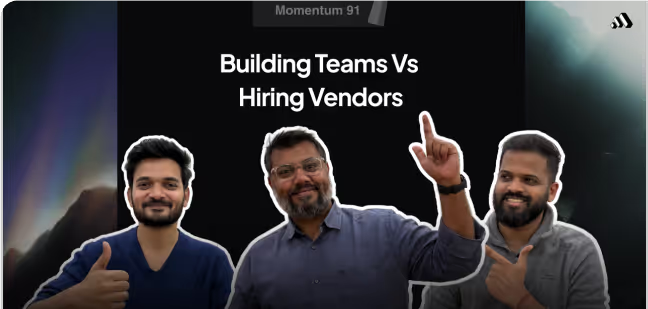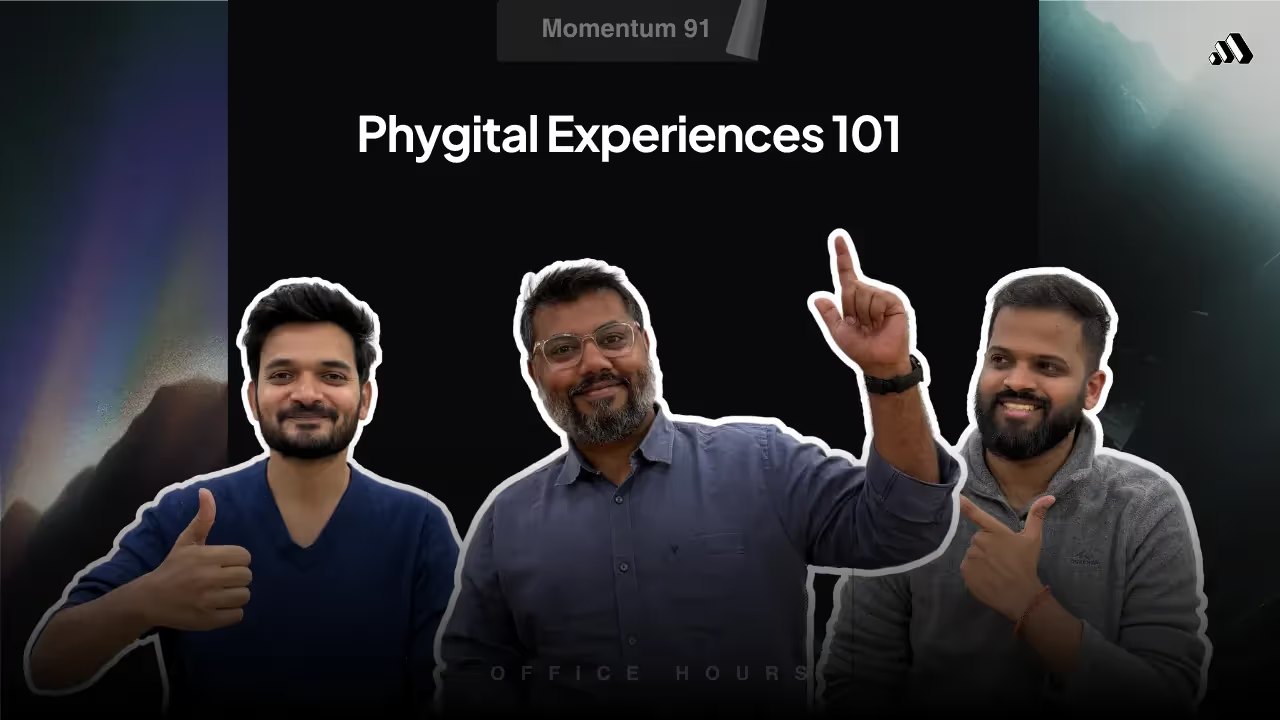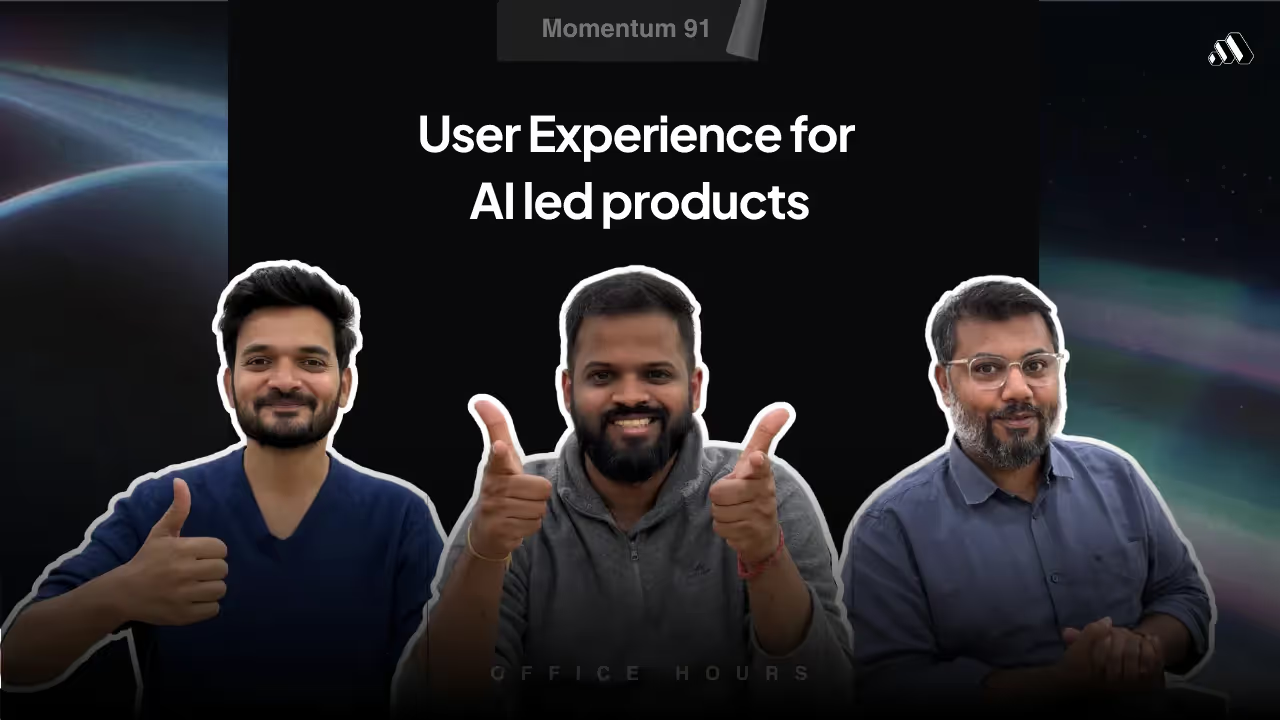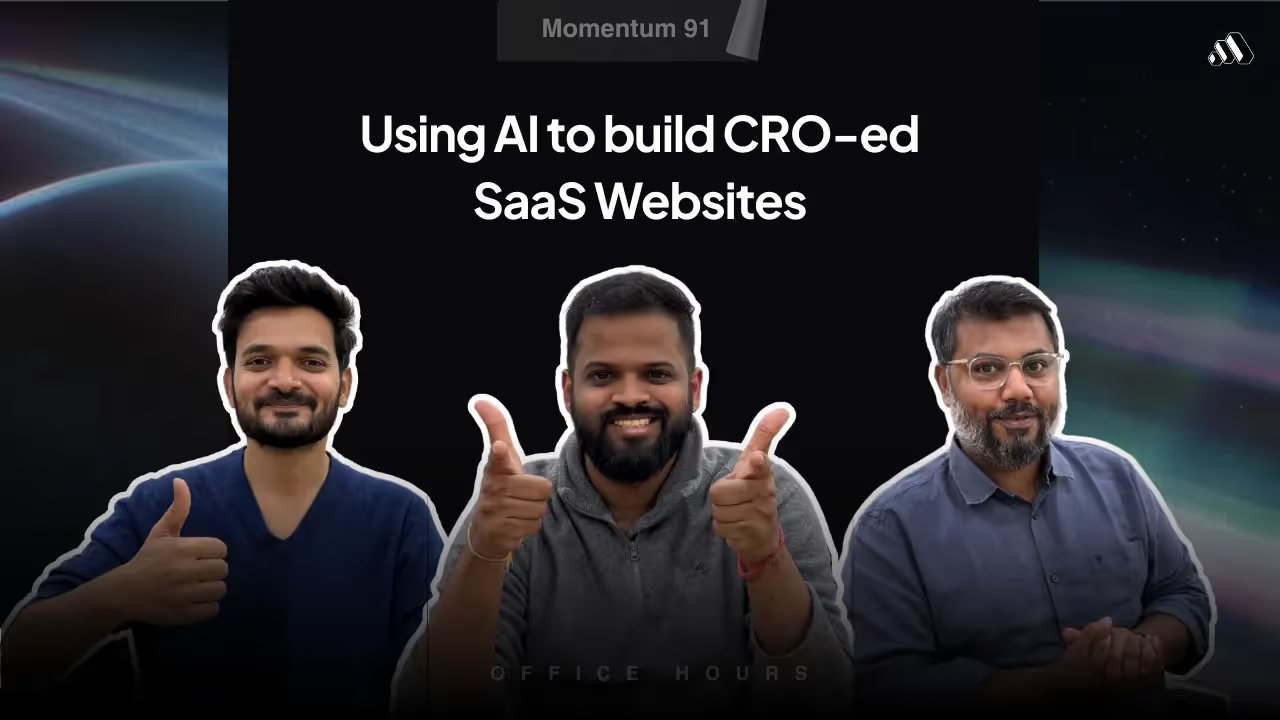Optimising conversions for Saas firms

Introduction
The conversation discusses optimizing conversion funnels for SaaS products. The main topics covered include the stages of the conversion funnel, the importance of activation, prioritizing optimization efforts, determining statistically significant data, and email marketing strategies.
Key Takeaways
- The conversion funnel for SaaS products typically includes stages such as awareness, engagement, interest, activation, conversion, retention, and expansion.
- Activation is a crucial stage in the funnel where users find initial value in the product.
- When optimizing conversion funnels, it is important to prioritize efforts based on the stage with the lowest conversion rate.
- Statistically significant data for conversion rates can be determined by considering a minimum threshold of unique monthly website visitors, such as 5,000.
- Email marketing can be used to nurture leads before sign-up and during the free trial stage, and metrics such as open rates and click rates are important to measure the effectiveness of email campaigns.
Transcript
Yash Shah (00:04.974)
It says live, perfect. Last time I noticed that when it says live, we are actually live two seconds after it says live. awkward silence for a second. But now I think we should be, we should be good. As it is, we do not have to worry. All of this is going on Jay's profile.
Hello and welcome to Momentum Office Hours. My name is Yash, and I'm joined by my co -founders, Harsh, Jay, and Kaushik, to discuss topic of the week, optimizing conversion funnels for SaaS. Our goal is to provide you with actionable insights and practical strategies that you can apply to your own products. Throughout the session, we encourage you to engage with us by asking questions and sharing your thoughts. This is a fantastic opportunity to learn from each other and gain new insights that can help drive your SaaS initiatives forward.
So let's get started. Jay, Harsh, Kaushik, how are we doing today? Yes, doing great. Doing great. Are we optimized for this session today? Yeah. I thought I would do some word play. Instead of saying, are we excited, said, are we optimized for this session? So OK, awesome. Perfect. So let's start. All of us are here. Who will go with the first question?
Okay, I can go. Yeah, so before optimizing, first I want to understand in optimize of funnel conversion, right? So I want to know the if we want to divide the funnel, right? So I want to know from we can say, which is to sign up right? And from sign up to the pad. But is there any party spark that I can see? Is there any
different participants. Is there any part you think I can see in this funnel? Yeah, sure. basically, there a of people coming. There are certain number of it ultimately going for a paid conversion. Anyone actually in SaaS there is more to it. The funnel does not stop at.
Yash Shah (02:23.842)
the purchase, right? So there are a lot of nomenclatures for the same. I like to put it in very simple way. So the first one is awareness. Awareness is where, you know, the possible users get to know about your product. So first is awareness. And then there could be the next one that is engagement. When I say engagement, it's basically, then let's say they are looking at your post and now following on your social media, or it could be anywhere like, you know, just learning a little bit about the product.
through blogs or any other way. So this awareness, getting an idea. Second is engagement. The third would be interest. When I say interest, they basically showcase some form of interest. They could just go for a paid trial or anything of that sort. Then comes the activation, where they find some value. So there are certain SaaS products which are not giving free trials. In those cases, this stage will be a little
different, but first ideally it is awareness, second is an engagement, the thought would be interest or desire you can say. In this interest stage if there is a sign up that is happening then after that there will be activation and then like after that there will be conversion so the free trial user will get converted into you know the paid customer so that is a conversion.
Ideally, in most of the cases, this page stage or conversion stage is where the funnel ends, especially in D2C brands or any such other funnels, you look into. Especially, but since it's a monthly subscription, it's also important that people who have users who have already purchased the product, also retain. And also, they upscale. the priority is also to upscale to the particular user. So in this case, it will be awareness.
engagement, interest, we can add one stage for activation after that conversion and then retention and expansion as well. So you can convert it in these stages. Okay, okay, great. okay, understood. So in this conversion, right, such like, such like in this conversion, it will take around one month, right, from awareness to we can say the last one, right.
Yash Shah (04:45.134)
I would like to correct you here Harsh, so it's not like that. So what happens is you can, so it varies from product to product first of all, the entire closing cycle and it also changes from persona to persona. So for example, would like to give a very, so client is a CRM for agencies and in that, you know that the ideal client persona is digital agencies from North America.
now especially 1 to 50 team size. But then there are other agencies from different geography having a larger team size or having a fairly smaller team size. Let's say there is a team of just three people starting an agency. For them also, client choice is useful. Now for their use case, it could happen that they are just at the starting of their agency phase and they may not be in extreme need of CRM, but they are also in looking out of CRM. So now they have started to read some blogs.
Getting aware they are part of now newsletter. They are subscribed to the same that is the second stage engagement where they have subscribed to the newsletter, right? So that is already there, but they have not gone ahead with the sign up. So this is again This could happen that they are in the funnel for six months and then on the six months It's the right point where you know, they're getting one more plan and then they feel like I need a client portal I need to mention maintain everything under the same, you know
same umbrella, so that they use CRM. So they try for this one. And now again, after going for the trial, let's say they are exploring three other CRMs as well. And in those cases, in that journey, it takes around 15 more days for them to come to the final conclusion. So the cycle is never one month. It is very subjective. then the good way to look at it, especially converting, mean, good way to observe the users is like, if there are a few users who are like,
problem aware, few are solution aware and few are product aware. So from someone to being just problem aware to product aware and then purchase the cycle could be anywhere from a month to it could take to 12 months as well or even more.
Yash Shah (06:51.374)
Yeah. Sorry, Harsh, you had a follow up question or? No, no, yeah, you can ask here. Yes. Correct. So the other thing that I want to understand around optimizing funnels is there are, as you pointed out, right, so there are certain stages of the funnel. If I want to, so today if I want to, if I have a SaaS company, I have certain conversion rates across the funnel. So let's, for simplicity, let's assume 100, sorry, let's assume
First step is 1000 and then 100 and then 10 and then 1. Let's say there are four stages and then I have a thousand people and then 100 people converting out of that and then 10 people converting out of that and one person converting out of those 10 across the funnel. And if I want to take up the project of optimizing this, where should I ideally start? From what, like should I start optimizing the conversion data that I have which is 10 to 1?
Or should I start from 100 to 10 or should I start from 1000 to 100? Which step do I optimize first? Right. ideally, I mean, I would personally suggest that we need to first understand what are those numbers, right? Because at times it happens. So let's say, so let's say 1000 people visiting the website, 100 people signing up, 10 people becoming a paid customer, one customer expanding.
buying more licenses later. So let's say that's the fun. Understood. So my approach would be to first have these conversion numbers, compare them with the industry average that we have. So as you mentioned that 1 ,000 are website visitors and from that, let's say 100 are signing up. So 10 % sign up is a really good number compared to industry standard.
one might not want to look into that. So in these cases, one might want to understand what is the further conversion that is happening. So a good way to look about it is the conversion numbers that we have, whether with industry standards, are they matching or not? So let's say they are below industry standard. In this, I said 1 ,100 and 1, because that's easier to sort of calculate. But let's say those are below industry standards. So let's say it is 1 ,050.
Yash Shah (09:11.938)
you know, five or something like that, right? So, I know that I need optimization. Right. Yeah. So, in this case, I believe it's always one should always focus on low hanging fruit. like some bottom of the funnel is the first approach that one should look up for that if those numbers are sorted, then you know, there is some form of predictability that if I am able to get good amount of signups by anyway, I know that now that I have solved bottom of funnel, so let's say signup.
paid is what we are able to get it. So that is something we can look up for. So if you talk about the target group, then bottom of the funnel definitely and if you talk about the stages, then definitely the final stage that is how many people are going for the purchase is what we should look up. So I should start with the smallest like the so bottom of the funnel first, then optimize the middle, then optimize the top. Right. Yes. But again, I would personally see the number of course.
But in general if you ask them yes. I know but in general right so let's say. Because I would like to add to that so just what happens is like we ourselves have seen right that lot of people are focusing especially on just bringing the maximum website visitors but now all the numbers let's say all the conversion numbers are below industry standards and they are only looking up for getting maximum website visitors that would not help because getting maximum website visitors would not allow them to understand
which of them is the ideal kind persona and that would lead them to going in different directions, not in a unified way and then there could be endless possibilities. I mean, there is no predictability in any form and that's why the earlier suggestion which I suggested was some.
Got it. it. Jay, I was trying to understand what you were trying to mention as stages. So for SaaS companies and SaaS products, there is a part where there is from lead to trial and from this stage of trial to paid customer. That two stages, the transition that happens and the metrics that's involved.
Yash Shah (11:23.766)
In your experience as well as what are you seeing, what are the common pitfalls that SaaS products or SaaS companies miss out on? for the metrics they miss out on, which they should definitely have. Because these two stages are the most crucial stages, from the lead to the trial stage and the trial stage. And then the trial stage to the active customer stage.
or the paid customer state. yeah, so well, having many coffees with you, I know that you are expecting me to talk about activation numbers and I'll say that is the one, right? So people at time what happens is, mean, what we have seen observed from founder's side is they are either focused on having, you know, maximum visitors and after that they are talking about converting and getting maximum create. But then at times what is being missed out is obviously the activation.
At times what happens is they have not defined in right. So let me first talk about what activation is. So when we say activation, there's a standard. ideally, it's basically, let's say people are signing up and from that particular stage, the point where they are able to find initial value is what we say the user is activated. So when I say activation number, so let's say 100 people are signing up and out of them, we have defined a metric based on the usage of the product that let's say
Let's say, for example, first document created in any document creating platform is the first activation number. So what happens is first time that many times people are signing up and then they are not generating the doc or creating a document to adjust over their exploring features and then they get turned out of there. again, coming to the point, activation number is something which I believe at times is getting missed and
reason, one of the main reasons is either it's a priority to get maximum people for sign up or either it's a priority to get them converted but then understanding this is missing out. At times the definition of activation in itself is not very defined and that's where the numbers are haywire and then the results are not up to them. So I was just saying that can we say that, so as it
Yash Shah (13:49.462)
initial stage. Sorry, sorry, sorry, sorry, sorry, sorry, sorry, sorry, sorry, sorry, sorry, sorry, sorry,
any startup, any initial SaaS founder who has just come up with their product out. We understand that identifying the value, just like for example, the document maker is something, an example you said. So does creating a document make someone an active user or creating and sharing the document makes someone an active user? So how do you clearly define who is the active user?
Perfect. So it totally depends on what value proposition you have with your product. So each and every SaaS product is going to have their own uniqueness in it. there are lots of document. I mean, giving an example of a documentation, document -making platform, or like Pandora or any of such. So in those cases, let's say you are a founder and you have produced a new product.
which is a competitor to it. But now your unique value proposition is that this document you can share directly via WhatsApp, so from your web platform as well and these kind of things. Just giving one of the examples. So in those cases, you have your value proposition in a way where, know, this is how you are different. So that is why people are going to opt for you, right? So in those cases, having that value generated should be, I personally would say, the
people who are doing that particular activity for the first time should be considered as an active user and not just creating a document. Yeah. I have another answer to this. So it depends on who am I telling the active users to. So if I'm telling active users to investors, anyone who signs up is an active user. If I'm telling the number of active users to my UI UX designer, three active document sent is an active user. So what I want to
Yash Shah (16:03.25)
I mean, obviously, this is a joke, but what I want to do is I want to like the people who are supposed to actually work on getting the users activated, I want to give as stringent of a definition as possible so that they are aligning the product in a way that they are that we actually get the activation rates or active users up. But that's a great question. It makes me feel like I should have thought of this.
question very interesting. Great point.
Yeah, so so if I want to optimize my funnel, right? So there are multiple strategies, right? So one of the strategies is the A -B testing, right? Where we do some changes and we will check whether the our funnel is optimized or whether conversion rate increases or not, So it's like we will change the CTA of bundle, right? Or we can change the pricing, right? So what do you think? Can you give some more examples of
you have done this type of changes in your website or platform and the conversion will be very high conversion will be increase very exponentially yeah sure so harsh wants the silver bullet don't give us strategies give us what you did that get us the like yeah yeah don't create value just give me the money don't create value so please go ahead yeah I mean
So the question that you asked, I suppose, 13, 15 minutes, whatever odd minutes we have left. If I try to answer that, would be completely filled out by that. But I will still try to answer it in a way where it makes sense. So first of all, A -B testing occurs in lot of things. So in different stages, we have different ways to make sure that people are getting converted. So let's talk about website visitors to.
Yash Shah (18:04.096)
sign up for instance, even before that, like someone visiting the website, for instance. So to make them aware of your product, you want them to come into the website. And so in those cases, you do ads. you need to have just giving you an example of A -B testing. So putting out an ad to your target users, what happens is how many people are seeing this and how many from them are actually coming to the website. That is one, or the landing page in those.
for instance. So you might want to change your landing page. Sorry, you might want to change your ad page or everything, ad copy. So you might want to change the graphics, the copy, and all of these things. So you need to optimize on that first of all. So it's just a trial and error that happens. You would launch first version to some users. You want another user. And then you compare between them, which one is getting better. So that is one.
Same A testing can also be applied inside the website or the landing page in itself or how you are putting your CTF. So a good way to do about it, like random, it's not like you do random A testing, you need to have the right metrics first of all, kept for each and every stages, where based on which you understand that, know, this is up to the mark and this is going right. So if you ask me that what you did for, know, what kind of A -B testing you did.
We have done it in lots of places, like in our ad pages, in our landing pages, as well as in the website. But all of these are tracked in right way. So for example, for a website, would look at the heat maps generated on a hot jar, try to understand where people are staying and whether they're leaking or not. And based on this, my next experiment would be planned.
Same way, from the product standpoint, we would want to understand where users are not going ahead from, so people not getting activated or anything. So for the same, I would want to plan a better onboarding journey. So in onboarding journey, also we could have A -B testing, understanding where the user flow is getting programmed. So A -B testing is applicable in all the stages, would personally say. So to answer that, what things I've done, I'd be happy to share over.
Yash Shah (20:28.906)
very long answer, if it's specific I could have a better answer. So if Harsh you are willing to pay money we can give you a longer answer also. so the thing is that we are very like if we give you the answer then what will we charge for? So there has to be some consulting you know
sort of creation of walls there which I think we protected. So, awesome. The other thing like from a conversion funnel standpoint is that, is how do you think of like it, what amount of data is becomes statistically significant, what amount of data is considered anecdotal.
So in the sense that at what point, like how much revenue or how much signups or how many visitors or how many customers or whatever those like what is the minimum threshold number that you look at before you say that okay, this is the conversion rate that we have as of now. And anything below that is just anecdotal. So anything below that is not an actual pattern, but it is just an event that has occurred.
or a collection of events that has occurred. How do you think about it?
Good question. like especially talking about the industry standards that we look at. First is website visitors to sign up. So for that, the anywhere up to seven to eight percent conversion is ideally considered as good. So anything below that is somewhere where we would like to keep a high priority focus and we would want to improve that. So website to sign up seven to eight percent. Same way.
Yash Shah (22:31.118)
talking about sign up to paid conversions is anywhere around 4 to 5 percent. No, I am not asking for optimal conversion rates or industry standard. I am trying to understand that at what number do you actually start to measure these rates. So as an example, if my website has 10 people visiting and if two people are converting as signups, the number 10 is so small that I should not go around claiming that my website has 20 percent conversion rate.
So what is that minimum number in place of 10? What is the minimum number where you say, okay, now whatever rates that we are seeing are actual conversion rates and these are not just random happenings or some random events. Right. So for website visitors, I would say 5 ,000 unique website visitors should be the number based on a month. month. Unique monthly website visitors, 5 ,000.
is something which one should look at.
And then everything else is sort Anything else will fall accordingly based on the... Then you want to see, you want to have 8 % or then if let's say out of 5000 you have 400 people which is 8 % signing up then it's optimized enough if you have lesser than that then you want to optimize that then out of 400 you said 4 % right so about 160 paid customers as an example.
Not 160, sorry 16 paid customers. so if you have less than 16 that you want to optimize for that. But anything less than 5000 unique monthly or site visitors, you say that the evidence is anecdotal, it is still not a pattern. It is just a collection of events. Anything above 5000 is when we are prepared to call it a pattern.
Yash Shah (24:32.302)
And again, like, see, one thing is for sure that again, we are talking in general right now, but then again, from 5000, it is also important to understand that where these are coming from. like, it's again, not that important. I mean, it is important to know where these are coming from. But we would also want to understand it. Are they actually following our ICP or not? But then again, if we don't have this number of
we should first focus on optimizing on that. So that leads to a chicken and egg situation, right? Because, then I tell you why. So as an example, I'm building a SaaS company with a hypothesized ideal client persona, right? So the ICP that I have written on day one is something that I think this product is right for. Then I go to the market.
and then I get some conversion rates and then I am trying to optimize for the conversion rate. But at the same time I am forgetting that the ICP is also hypothesized. So, what do I fix first? Do I fix the ICP definition or do I fix start fixing the conversion rate for like you are understanding what if I am optimizing the conversion rates for the wrong ICP? And what is the ICP, in and of itself is wrong? how do you go about it?
that that makes sense. So I mean, in this case, first of all, obviously, ICP is something which we can define only once we have a certain set of buyers and from that we define. Otherwise, it's a hypothetical, as you mentioned. in this case, first, again, I would come to the point where we would first focus on how many people are coming to the website and the further steps are being taken care from. So ICP could change from time to time, and which we have observed with lots of
our client partners as well, right? But the focus initially should be to have those visitors. See, initially when we are launching the product, when we don't have that many visitors or any of the good numbers, we know that initially we are into market validation standpoint as well. So from there, the work thing happens. So obviously, first priority would be to have those visitors. And then if there is a need of pivot, if you need to change the ICB also.
Yash Shah (26:53.068)
that is okay but what I was coming to from the earlier point is that these visitors which are coming we would want to understand who are these visitors understand their persona and check whether they are falling under hypothetical condition or not if not we should rather rather than just focusing on same hypothetical ICB we might want to change the ICB and you know get things sorted for that because the product is itself getting those visitors so but I think that regarding it was very interesting because
Choosing ICP is so critical. There's one interesting point that came up while we were trying to define. I think if you are choosing, most of the times good pivots are finding ICP which is a subcategory within the primary ICP that they chose. To give a good example, Switch initially was a platform where
There was a single guy who was just streaming itself where they were targeting them. They were putting the product as a video streaming platform. And then slowly they realized that the majority of the people who were using were gamers and they turned the whole platform into a gamer streaming space and the platform for that. So I think your initial ICP that you're identifying will guide you to the dedicated cohort within that.
can pivot and start focusing on over there. I don't think you can, like your ICP shouldn't be way beyond what you initially defined. It can't be completely opposite of, then it means that there is something really wrong going on. But there have been those cases as well, right? So there have been cases like Twitter is a great example of that, where what they started to, they instead of, like they pivoted the whole product.
They were sort of a broadcast messaging solution and then they became whatever it is today. but this is an interesting current term. We have gone away from conversion rates into like while fixing the conversion rates do we fix the ICP or we don't fix the ICP, we keep the ICP as it is we fix the product for
Yash Shah (29:18.104)
for an ICB that you define, but it's interesting. We have time for one last question. Harsh, do we have one last question? Yeah, I have. So in this optimization, think email marketing is also one of the major strategy that can help us to convert the lead. So what are the metrics that we should follow in this email marketing? What are the things that we should do in this email marketing?
So we can say the product companies, right? Can these are the new features that are available in product, right? We can also talk about the industry, right? They are our clients, right? So what are these things that we can improve in e -mail marketing? Right. So e -mail marketing will be used in both the cases, even when sign up is before sign up and after sign up as well, right? So before sign up, I would say if someone is signing up for news, I like to...
You know put everything in single place and try to answer your question. First is let's say there is no sign up done But then person is in engagement stage where they have subscribed to the newsletter in those cases email marketing will be used where on a weekly or on a monthly basis Something will be going on which is giving value addition to them product in itself may not necessarily be a solution to it But something that is giving value to it. So inclined to it was agency to so in those cases we used to
Send them on how to grow your team, how to be profitable in your agency, those sort of information we used to share. Because in those cases, building community is important. yeah, email marketing can be used to nurture. In this case, we call it nurturing. After that, let's say sign up is happening. And in that sign up now, especially when a person is in free trial stage, that's where we are using drip sequences where
In the platform, also, they are trying to give value. then apart from that, there are several mails that are going on from any accounts managers side. Or at a very early stage, could be from founders side as well. And they will again be asking about where you're able to do this. Now, there are so coming to the metrics, obviously, just like any email campaign, like the open rate, conversion rate.
Yash Shah (31:40.034)
Because in those emails, at times it happens that three days are gone and then there is an email going on to that particular user saying that, hey, you signed up, but you have not used this thing. So you might want to take a look. With Better Copy, we can have that messaging. And then a CTA is there. Once they click on that, it will take them to a journey which would eventually lead them to getting to an activation state. So again, in this case, the email marketing, we would be considering the click rates.
So same as other email marketing campaign, open rates, click rates are the ones which are going to measure. then each and every use cases will have its own meaning and value, for sure. OK. So mostly we can say click rate and open rate will be the one that we should consider.
Open rates and click rates both. Awesome. Everyone, thank you for joining in. Thank you, Jay, for patiently answering our questions and not answering Harsha's question. So that is, you saved us some money. that's good. But also, it is a good conversation. And for all the people who watched us, listened to us,
commented on the post. Do check out Momentum91. If you're running a SaaS product, we'll be able to help you build a better version of your product faster. We may have our internal questions, but we always have one person who has all the answers, at least one of the four of us. And we try to ask questions on your behalf. But thank you for joining in. Wherever you are, do consider subscribing. Do consider following.
and we'll see you again until next time. Bye.
The inbox update you’ll never want to skip
A quick catch-up with ideas, wins, and tips worth stealing, straight to your inbox every week.
The easiest way to reach us.
Share your details and we’ll get back within 24 hours.
Office hours
A plethora of insights,all in one place
From strategy to execution. All the big ideas, practical guides & fresh perspectives that’ll help you scale with confidence
Ebooks
Comprehensive guides that break down the shifts in business and technology, Helping you lead with clarity.

Office Hours
Your direct line to our experts. Practical advice for scaling, right when you need it.

Reports
Data-backed perspectives on where industries are headed, giving you the foresight to make bolder moves.

Newsletter
A quick catch-up with ideas, wins, and tips worth stealing, straight to your inbox every week.
.avif)
Podcasts
Conversations where you get to know everything from the ones who know it best.
.avif)
Your Offshore Development Center, Done Right
Access top-tier global talent, enterprise infrastructure, and complete regulatory compliance through our proven model.
Start Now

.png)






